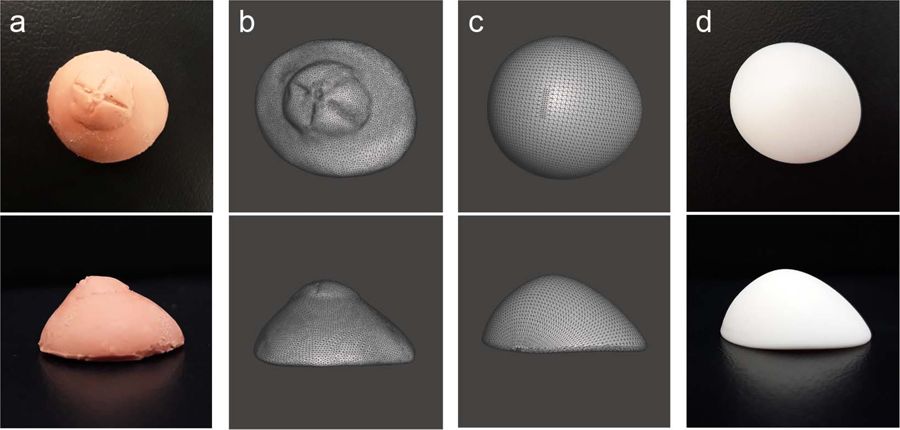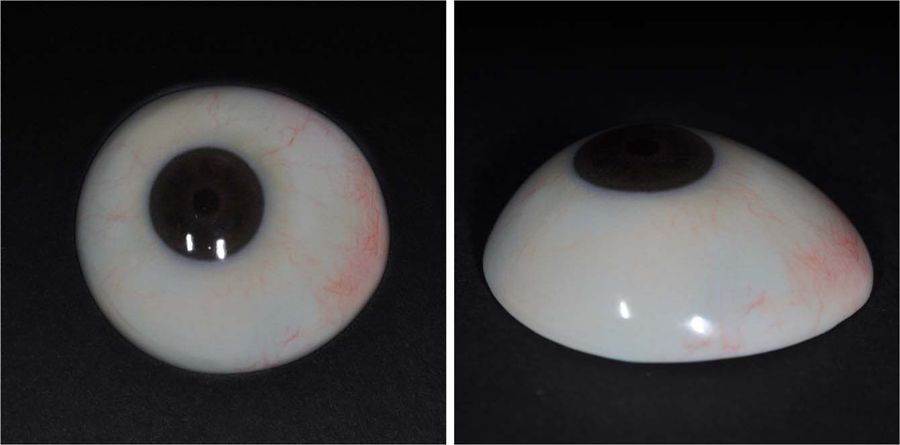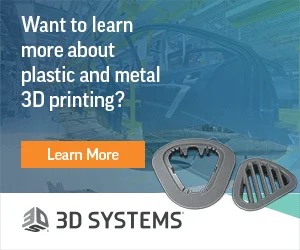In a previous post we mentioned the work of a team from the Severance Hospital South Korea on ocular prostheses. Led by Professor Yoon Jin-sook and working together with artificial eye maker Baik Seung-woon, the team was able to create an artificial eye using 3D printing technology. Recently the study of the project has been published and it explains in detail how they did it, that is the reason for this post.
The loss of an eye can have several physical and psychological consequences for people. It reduces by half the ability to see and also alters considerably the appearance of the person. Nowadays restoring the sight from a lost eye is not possible, but a prosthetic eye can improve the aspect of the person. Cosmetic rehabilitation using custom-made prosthetic devices in the form of ocular prostheses helps upgrade an individuals quality of life.
Professor Yoon said,
“Our team plans provide top-notch public health services through high-quality artificial eyes and a network that can increase patient access.”
The first step to create a 3D printed custom eyeball to obtain an impression of the target patient’s eye socket to determine the shape and size of the prosthesis. Once the mold is taken, it is necessary to create a high-resolution image of the model and digitally correct the file.
Directly from the abstract:
“In this study, we used a light intensity 3D scanner (Cara Scan 3.2, Kulzer Inc., Germany) that reflects the laser beam from the surface of an object to obtain 3D model data.
“The resultant image can include noise and artifacts, which inevitably had to be removed to produce the 3D model. This was achieved using the graphic editing software ZBrush 4R7 (Pixologic Inc., Los Angeles, CA, USA) to remove the internal and external noise of twisted meshes and to correct artifacts using the healing wizard function. Moreover, the software was used to smoothen the surface of the impression model.”
Once the STL file is ready, it is possible to 3D print it.The polymer used for the Severance team is a biocompatible photopolymer resin (FotoTec DLP.A, Dreve Inc.) as the base material.
After evaluating the cytotoxicity of the material, the cytotoxicity of the final product was assessed in accordance with the ISO 10993-5 recommendations.
The 3D printer used by the Korean team is a Carima DS131. It is a digital light processing (DLP) 3D printer with 50-μm resolution in the X–Y plane. The Z-axis, that is, the layer thickness, can be set in 25-μm increments. It is a high-resolution 3D printer usually used for dental solutions.
To create a sense of realness, the sublimation transfer technique was used to print the image of the iris and blood vessels on the 3D-printed ocular prosthesis. For this technique, the desired pattern was printed with biocompatible ink on transfer paper. Once ready, the output of the ocular prosthesis is printed with a dye-sublimation transfer system.

Printing iris and blood vessels onto printed ocular prosthesis (a) The contralateral normal eye was photographed using a slit lamp. (b) Image of contralateral normal eye modified for printing. (c) Image of iris and blood vessels transferred to 3D printed ocular prosthesis.
Finally, the ocularist applied a transparent to the 3D printed ocular prosthesis to complete the fabrication process.
The amount of time that traditional processes need to make an eyeball is around 10 hours compared to the 8 hours that the 3D printing manufacturing process takes. It is not a large difference if we look at the numbers. However, it has to be considered that with 3D printing the amount of manual labor is reduced to 3 hours from ten.
The proposed method reduces the time and skill required to fabricate a customized ocular prosthesis, and is expected to provide patients with easier access to quality custom-made ocular prostheses. Now, the craft of making eyeballs is considered an artistic work that consumes a large amount of time in manual labor and needs highly skilled professionals. Semi-automated fabrication of prosthetic eyes reduces considerably the amount of manual labor and the need for technical expertise. Although, this technique requires skills as well in software for 3D graphics and modeling, which were not previously required. Taking all into consideration, 3D printing should make ocular protheses much more affordable and available.
Also, the use of 3D printing for this purpose can be considered an improvement when it is necessary for the replacement of the eyeball when the piece has been lost or damage. Because it is possible to store the data of the patient, it is not necessary to repeat the whole process, it can just be printed. Although it is important to mention, that the space of the eye socket may change through life due to age or weight changes. And one of the great features of existing eyeballs prosthetics, whether are made of glass or synthetic materials, is the capability of being reshaped if necessary to fit the patient’s evolving needs.
So, all together, the advantage of using 3D printing manufacturing methods for this purpose is the shortening of time and skills necessary to make a custom eyeball prosthesis. It would reduce the waiting periods to get a prosthetic eye and will make it cheaper by reducing the time of skilled professionals. It is exciting to think what it could bring for developing countries where there are not many artisans specialized in eye making.
So far the study has been focused on the development of the 3D printed prototype and manufacturing processes. It didn’t include human trials, therefore, the cosmetic outcome and the patient’s comfort when wearing the fabricated ocular prosthesis has not been measured. The next step to prove the worth of the findings would be to conduct clinical trials for the proposed method. Hopefully, in the near future, we can bring you positive outcomes of such trials.
[Source: “Semi-automated fabrication of customized ocular prosthesis with three–dimensional printing and sublimation transfer printing technology“]Subscribe to Our Email Newsletter
Stay up-to-date on all the latest news from the 3D printing industry and receive information and offers from third party vendors.
You May Also Like
Al Arkan to 3D Print in Saudi and Beyond, Interview with Tarek Alhalabi
Dar Al Arkan is a Saudi-listed real-estate company that has built over 15,000 homes as well as malls, planned developments, and luxury villas. Active in eight countries, including Saudi Arabia,...
ICON’s New Wimberley Springs Project to Feature 3D Printed Homes from CODEX Catalog
Additive construction (AC) firm ICON continues to push forward America’s homebuilding industry. Now, the firm announced a project consisting of eight single-family homes for the community of Wimberly Springs, Texas....
3D Printing Webinar and Event Roundup: July 14, 2024
We’ve got a busy week of 3D printing webinars and events, both virtual and in-person! Stratasys continues its training and tour, while a Laser Additive Manufacturing workshop will be held...
3D Printing Markets Grows 8% Year over Year
Despite a market slowdown in 2023, the additive manufacturing (AM) sector continues to grow at a robust rate, according to AM Research. The market analysis firm published its Q1 2024...


































